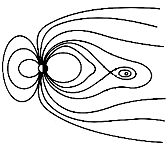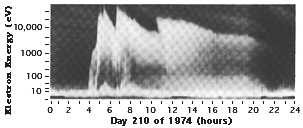|
The exact way in which this energy is released, and the "trigger" which starts the process, are still subjects of debate and controversy. But it is widely held that the critical event is the formation of an X-shaped neutral point, or more likely, a neutral line extending some distance across the tail. That is not the distant neutral point of Dungey's theory, but an additional one formed quite close to Earth, at a distance of 15 to 30 RE (drawing on right).

Magnetic reconnection then begins between oppositely directed field lines north and south of the middle of the plasma sheet (the "equatorial plane"), as explained in connection with the open magnetosphere. Each line on the northern side is broken in two at the neutral line, and the parts are spliced to corresponding parts of a line from the southern side, which is similarly divided in two.
The broken and reconnected halves of lobe field lines form two new lines. The one on the earthward side, essentially a stretched terrestrial line, rebounds earthward, just like a released slingshot. The other one is connected tailwards, and because it no longer has any connection to Earth, it is expelled down the tail. Together with the plasma riding on it (and other plasma, originally further tailwards), it forms a sort of a plasma bubble known as a "plasmoid" (see drawing above). The passage of such plasmoids further down the tail has been deduced from observations by ISEE-3 and Geotail.
Initially the newly-reconnected lines are those of the plasma sheet, but as the process sucks in magnetic field lines from both sides towards the neutral line, the tail lobes are soon reached. The effect on the magnetic field piled up in the lobes, and on the energy stored in them, is somewhat like that of a pin on a well-inflated balloon. Just as the pinhole allows air to escape and releases the energy stored in the balloon, so the neutral line allows field lines (with their plasma) to leave the lobe, reducing both the intensity and energy of the magnetic field there.
Energy in nature is conserved. If it disappears in one form, it reappears in another: electric energy consumed by a motor is converted to kinetic energy of motion, and when motion is stopped by friction, its kinetic energy turns to heat. The magnetic energy taken from the tail lobes also reappears in different forms.
Some is turned to heat, that is, it raises the velocity and hence the energy of plasma ions and electrons (heat being the kinetic energy of individual particles moving in disordered fashion--in both a gas and a plasma). The plasma most likely to be heated in this process is the one attached to the reconnected field lines: since those lines come from the tail lobes, whose plasma is extremely rarefied (see magnetotail), rather few particles share this energy and therefore the amount each of them receives may be quite big.
Electric Currents
Some of the converted energy ends up driving electric currents, in a circuit linking the plasma sheet and Earth. The connecting links are magnetic field lines, which can conduct electric currents quite well, since ions and electrons attached to field lines slide rather easily along them.
As noted (section on magnetotail, also drawing on right), a large electric current flows at all times across the plasma sheet, from the dawn edge to the evening edge (and then closes along the magnetospheric boundary). In a substorm some of this current, it seems, is diverted earthwards along magnetic field lines.

The diversion starts in the morning-side half of the plasma sheet, where currents are withdrawn to flow earthward along field lines. They then continue (mostly) in the ionosphere, and finally return to space along other field lines, to the evening-side of the tail. The by-passed section in the middle of the plasma sheet, where the cross-tail current is weakened, seems also to be the region actively involved in the substorm, but how the substorm disrupts there the orderly flow of the cross-tail current is still a matter of controversy. The flow of electric currents along field lines may also be the key to the production of the substorm aurora, as will be discussed later.
Substorms in Perspective
The preceding account is explicit and tidy, suggesting a rather clear picture of what goes on in a substorm. Actually, much is guesswork: we have some pretty reasonable hunches, but nature may yet surprise us. For instance, the details of reconnection in the tail are hard to confirm, and its location and even existence are still being disputed.
Even though the physics is quite different, one can compare a substorm to a thunderstorm. Meteorology experts have a clear and orderly view of this phenomenon: its energy is supplied by the moisture contained in warm, humid air, and a rising flow forms an updraft (like the rising central column in the pot shown in the section on convection), extending to great heights. One can describe the processes controlling the flow of air in that central "updraft" and the formation of rain (and even of lightning, a somewhat peripheral phenomenon).
But a look at an actual thunderstorm reveals no tidy structure: flows are obscured by clouds, patterns are deformed, neighboring thunderstorms affect each other, and each storm is in fact different. An observer watching from the ground may find it hard to draw any conclusions. Launching balloons with instruments into the storm could help, but if only a few are available, their evidence may be contradictory, since those that miss the rising updraft move unpredictably.
Substorms are like that, too, only more difficult--because of their greater distance and size, the small number of satellites available and perhaps the greater intricacy of plasma phenomena. Almost all we know about them comes from ground observations or from isolated satellite passes, which cannot be readily combined, since each storm behaves differently.
|



